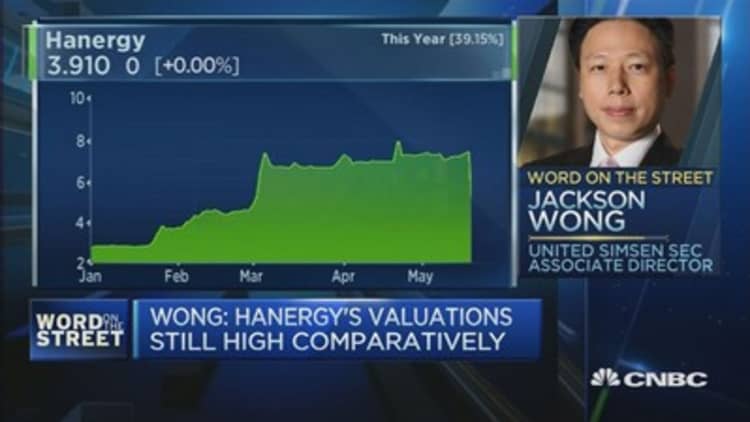China's equity markets stood out amid mixed trading in the region on Thursday, as investors bet on further economic stimulus from Beijing after a preliminary reading of the country's massive factory activity came in below expectations.
The HSBC flash Purchasing Managers' Index (PMI) came in at 49.1, indicating that the country's manufacturing sector contracted for a third straight month in May. The reading was weaker than the 49.3 print forecast by Reuters, but better than the 48.9 final showing in March.
Overnight, U.S. stocks failed to hold record levels and finished narrowly mixed after Fed minutes mostly confirmed market expectations for a rate hike later this year. As a result, the Dow Jones Industrial Average shed 0.15 percent, while the S&P 500 and the tech-heavy Nasdaq ended nearly flat.
Mainland markets mixed
China's benchmark Shanghai Composite index closed up nearly 2 percent to its highest level since April 28.
"Markets are still in a 'bad news is good news' mode. The important takeaway from this PMI reading is we are still not seeing inflationary pressure on the Chinese economy; demand is very weak and production is still going down, [which means] that monetary easing can go much further from here," Hao Hong, MD of Research and Chief Strategist at Bank of Communications International, told CNBC.
Pharmaceuticals were among the day's top gainers; Kangmei Pharmaceutical rose by the daily maximum allowable of 10 percent and Guangzhou Baiyunshan Pharmaceutical jumped 3.7 percent. Airliners also attracted robust buy orders; Air China soared 3.1 percent, while China Southern Airlines and China Eastern Airlines climbed 2 and 1 percent, respectively.
Meanwhile, BYD's Shenzhen-listed shares surged by the daily limit of 10 percent after the central government's "Made in China 2025" plan.
Hong Kong shares sagged 0.2 percent, with Goldin Financial Holdings in focus after tumbling 44.25 percent.
Analysts say the sudden collapse and trading halt of Chinese solar firm Hanergy Thin Film Power Group in the previous session could have been the cause. "Hanergy's specutacular rise was due to speculative buying interests from China... and the collapse yesterday triggered some selling pressure on other stocks that have seen similar [upswing] patterns previously, like the Goldin family," said Jackson Wong, associate director at United Simsen Securities.
Meanwhile, Lenovo Group said on Thursday its annual net profit rose one percent to $829 million, missing analysts expectations. Shares of the world's leading PC maker rallied 1.7 percent after briefly falling into negative terrain.

Nikkei flat
After scaling a fresh 15-year peak earlier in the day, Japan's Nikkei 225 pulled back and eventually settled in neutral terrain. The Tokyo bourse touched 20,320 points in intra-day trade as a weaker yen overnight and Wednesday's upbeat first-quarter growth figures buoyed sentiment.
The day's top performer was Panasonic, which closed up 2.3 percent at its highest level since October 2008, after it said it would increase its investment in the automotive business industry. Following the announcement, Nomura Securities raised its rating to "buy" from "neutral," further driving interest for the stock.
MS&AD Insurance closed up 5.4 percent on the back of plans to buy back up to 10 million shares.
Meanwhile, the Bank of Japan kicks off its two-day policy meeting on Thursday.
Read MoreWhy one strongquarter won't save Japan's year
ASX rises 0.9%
A softer Aussie dollar helped the benchmark S&P ASX 200 index to brush off pressure from falling commodity prices and finish higher on Thursday,
"A stronger US dollar has played a big role in some of the key regional markets. While the Fed's minutes essentially took a June rates lift-off possibility off the table, the U.S. dollar still managed to rally against the majors." Stan Shamu, IG's market strategist, wrote in a note.
Miners defied the 2.4 percent drop in iron ore price overnight; Fortescue Metals closed up 2.4 percent, while Rio Tinto and BHP Billiton moved up more than 1 percent each. Energy producers Oil Search and Woodside Petroleum elevated 1.8 and 1.6 percent, respectively.
Within the financial sector, Commonwealth Bank of Australia, Australia and New Zealand Banking and Westpac Banking rebounded more than 1 percent each, while National Australia Bank held on to a 0.5 percent drop.
Outperforming the bourse, building products group James Hardie Industries leaped 11.6 percent after reporting a 12 percent rise in full-year profit.
Meanwhile, the New Zealand government is expected to return to budget surplus in 2016 for the first time in eight years, said finance minister Bill English as he delivered the country's annual budget on Thursday. However, the surplus will be smaller than previously estimated due to low dairy prices and a reduced tax take.
The local stock index inched up 0.234 percent, while the kiwi dollar ticked up 0.4 percent to fetch $0.7330 against the U.S. dollar.
Read MoreHow to cool housing hot spots, Down-Under style
Kospi loses 0.8%
South Korea's Kospi index saw its biggest single-day fall in two weeks as profit takers swooped in following Wednesday's three-week closing high.
All of the top 5 weighted stocks declined, with Shinhan Financial falling the most by 2.06 percent. Following a two-day rally, Samsung Electronics eased 1 percent, while Hyundai Motor receded 1.9 percent.
Recent top performers such as Kia Motors and Shinsegae also took a beating, by closing down more than 2 percent each.

